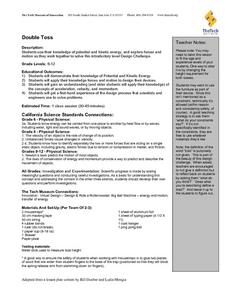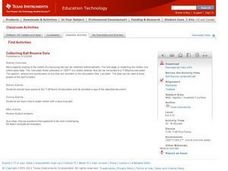Curated OER
Design a Bobsled
Young scholars apply their knowledge of friction, drag, mass and gravity as they design, build, and test mini-bobsleds.
Texas State Energy Conservation Office
Investigation: Conservation of Energy
By rolling marbles down a six-foot length of track, physical scientists determine how much energy is lost to heat. It is recommended that you opt for the foam pipe insulation track because more friction slows the marble, allowing...
Flipping Physics
AP Physics 1: Rotational Kinematics Review
A comprehensive review of the rotational kinematics covered by the AP Physics 1 test, this fast-paced video is designed to help scholars review material they have already been taught.
Flipping Physics
AP Physics 1: Kinematics Review
Test takers stressing out over the upcoming exam? Help them prepare for the AP Physics i exam with this fast-paced video that includes a complete guide to everything related to kinematics. Also included are some common errors...
Curated OER
Speed
Fifth and sixth graders practice working in pairs to determine whether they can walk with constant speed. They test themselves, collect their data, draw graphs with their data collected, manipulate the data, and then draw conclusions...
Curated OER
Worksheet 3: Graphing Speed and Time
In this graphing speed and time worksheet, students answer 7 questions regarding graphing, speed, distance, derivatives, Newton's method and wheel radius.
Curated OER
Boarding School
Learners discuss conservation of energy using a skateboarder in the halfpipe or a person on a roller coaster as an example. Using mathematical equations, students examine potential and kinetic energy of the examples. Lesson is completed...
Curated OER
Double Toss
Students experiment with potential and kinetic energy. They design a device that will toss a ball at least 30 centimeters, catch it and to the ball up again.
Alabama Learning Exchange
Energy and Work Amusement Park Style
Students distinguish between kinetic and potential energy. They recognize that energy can change from one form to other forms. They identify and describe several forms of energy.
Curated OER
Sciences Working Together
Learners research articles about science technology and society. In this science and technology lesson, students answer questions about an article they chose. They share what they learned with their peers.
Curated OER
Collecting Ball Bounce Data
Learners investigate quadratic equations as they use a CBR to collect and analyze data regarding a bouncing ball. Pupils explore different methods for determining the equation of the parabolic path including quadratic regression and...
Curated OER
Impulse and Momentum
Students are introduced to the concepts of impulse and momentum and problem solving strategies for these types of problems. In groups, they discover the law of conservation of momentum and share their answers with the class.
Curated OER
An Introduction to Sensors
Students research the International System (SI) of units of measurements. They make measurements using the metric system. They study key concepts used in building and use of sensors, how sensors work and their role in measuring...
Curated OER
Parametric Races & Slopes
Learners investigate the slopes and parametric equations. In this calculus lesson, students solve parametric equations with specific parameters. They relate lines and slopes based on the derivative of the equation.
Curated OER
Aircraft Trajectory Problem Set
High schoolers read text from a NASA Web-based textbook then demonstrate an understanding of the text by using it to complete an activity on aircraft trajectories.
Curated OER
Angles: Angles, Angles, Everywhere
Students estimate and accurately measure the size of angles communicate with the appropriate geometric terms and symbols to describe and name angles, lines, line segments, rays
Curated OER
Worksheet 21 Spring 1996
In this math worksheet, students consider a path around the unit circle parameterized by σ on the interval [0, 1] with σ(t) = sin(5πt − π), cos(5πt − π). Then they find the vector.
Curated OER
#22 Frames of Reference: The Basics
Students explore the concept of frames of reference in physics.
Curated OER
Mathematical Techniques - Basic Graphing
Students are introduced to significant figures and how to add, subtract, multiply and divide them. In a group, they practice plotting data points from a table to a graph and labeling all axes. They calculate the slope and y-intercept and...
Curated OER
Rocket Physics
Students investigate the relationship between impulse, momentum, kinetic and potential energy and aerodynamic drag. In this physics lesson, students calculate data taken from launching a rocket. They compare the theoretical and...
Curated OER
Measuring the Speed of a Wave
Students create an experiment in which they measure the speed of a wave and record the data in a graph. They work in small groups to write the procedure for the experiment and share it with another group for cross checking of the...
Curated OER
Vectors
Pupils differentiate distance and displacement. In this physics lesson plan, students use formulas to calculate for displacement. They draw vectors using the grid.
University of Colorado
University of Colorado: Ph Et Interactive Simulations: The Moving Man, Motion, Velocity, Acceleration, Position
Enhance study of motion, velocity, acceleration, position and graphing with this interactive simulation.
Texas Education Agency
Texas Gateway: Motion Equations for Constant Acceleration in One Dimension
By the end of this section, you will be able to do the following: Calculate displacement of an object that is not accelerating, given initial position and velocity; Calculate final velocity of an accelerating object, given initial...























